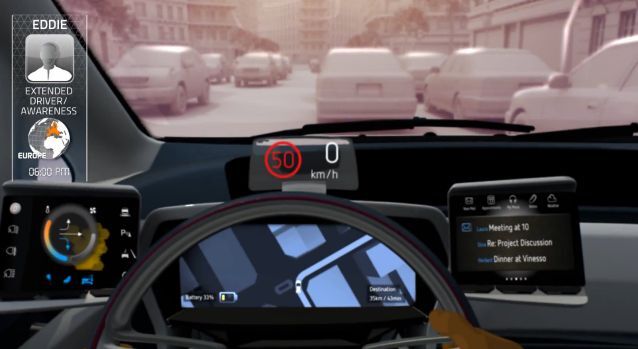Automobile systems manufacturer Visteon has unveiled its Nissan Leaf-based e-Bee concept car, designed to showcase some of the company’s visions for mobility technology in the year 2020. Car-sharing will apparently be much more prevalent by then, as many of the car’s features are centered around allowing multiple users to adapt it to their liking.
Probably the most prominent of these features is the e-Bee’s ability to store numerous user profiles in the cloud. In this way, each user could initially get the look, color and layout of the digital instrument panels set up the way they prefer, then save those settings. Every time they used the car subsequently, they could just reload that profile from the cloud.
There are three of those instrument panels, two of which are touchscreens located on either side of the steering wheel. They provide information on vehicle controls and social media connections. At the center, immediately in front of the driver, is the head-down projected main display – this is where the most vital information, such as driving speed, is accessed. Where the rear-view mirror would ordinarily be, the e-Bee instead has a video monitor displaying a real-time feed from a 180-degree rear-view camera.

Different users can also also physically adapt the interior to their liking, thanks to a series of clip-on modules. These include things like cup holders, wireless charging devices, and additional cameras to increase visibility.
Along with individual headrest-mounted audio systems, each occupant also has access to the climate control system via controls in the door panels, and can use it to raise or lower the temperature in their own “climate zone.” That system is located in the climate module, which combines the heating, ventilation and air conditioning (HVAC) unit with the refrigerant system.
By being mounted in the engine compartment, the climate module opens up more interior space – ordinarily, most HVAC components are located inside the dashboard. Space is also saved by putting the airbags in the headliner, and by mounting controls and displays on independent local structures, instead of on a central cross-car steel beam.
The car’s HVAC system additionally incorporates a gentle air diffusion feature, a cooled rear grocery storage box, and – in case there’s a passenger who stinks – a fragrance diffusion system.
Materials used for the interior include recycled and bio-based resin and natural fiber hybrid materials, along with weight-saving recyclable expanded polypropylene.
The e-Bee made its public debut this week, at the Electronica 2012 Trade Fair in Munich. Some of the car's features are highlighted in the video below.
Source: Visteon





